
Red Dot sights are used with both eyes open, dot on target, eye to eyepiece, center alignment not required. They are fast in use, highly accurate and resilient in most any environment. At least that was how they were defined in 1974 when the Swedish company Aimpoint introduced the first red dot sight. These days, there are lots of low-end knockoffs riding the coattails of Aimpoint’s reputation but, in many cases, they don’t even perform to the original red dot concept.
| Company | Aimpoint |
| Origin | Sweden |
| Type | Reflex Collimator Red Dot |
| Model | Micro H-1 |
| Dot Size | 2 MOA |
| Application | Handgun. Rifle, Shotgun |
| Parallax | None |
| Eye Relief | Unlimited |
| Battery Type | CR2032 |
| Battery Life | 50,000 Hours |
| Intensity Settings | 12 |
| Housing | Black Anodized Aluminum |
| Optics | Multicoated Ground Glass |
| LxHxW – Measured* | 2.4″x1.5″x1.6″ |
| Weight* | 3.9 oz |
| Objective Lens Diameter | 20mm |
| Ocular Lens Diameter | 20mm |
| W/E Adjustment | 1/2 MOA |
| Operating Temperature | -20°F/+140°F |
| Humidity | 95% at 68°F |
| Other | Fog, Shock and Water Proof |
| Price – Typical | $580 – $600 |
|
Includes Picatinny / Weaver Mount |
|
The Aimpoint Micro H-1 Red Dot reflective sight has been a successful product since its introduction in 2007. It’s a safe bet that the 2 MOA version, introduced during the first quarter of 2012, will make a major contribution toward extending the run. So how does Aimpoint justify a $600 sight system when other companies are selling products that look very similar at a fraction of the cost? By Aimpoint continuing to make a product that justifies the price.
Many red dot sights are not parallax free
Red dot sight optics are as critical as they are for a conventional scope, even if for different reasons. Light from an LED is projected onto a front lens and then projected back to the shooter’s eye. The lens is selectively reflective as all but the LED light passes through the lens, which allows the view beyond the sight to appear transparent to the shooter with the exception of a red dot.
The tiny LED that forms the red dot is mounted inside the sight’s body, just forward of sight’s ocular lens, and angled toward the center of the sight’s front objective lens. Most budget red dot sights use a single element objective lens that reflects light back to the shooter at an angle. The farther the red dot is viewed from the center of the eyepiece, the greater the angle of the reflected light, the greater the disparity between point of aim and point of impact, parallax. By utilizing a two element objective lens, Aimpoint eliminates this problem.
 The light from the Aimpoint’s LED projects through the first objective lens element and is reflected back by the second. As the light reflected by the second lens passes back through the first lens, refraction straightens the light and makes it parallel to the sight’s optical axis. So no matter how or where the red dot is viewed in a properly zeroed Aimpoint eyepiece, point of aim is always in alignment with point of impact. No red dot sight company that sells a single element objective lens product can claim that it is parallax free or that the shooter’s eye can be misaligned with the center of the eyepiece and the red dot will still represent point of impact.
The light from the Aimpoint’s LED projects through the first objective lens element and is reflected back by the second. As the light reflected by the second lens passes back through the first lens, refraction straightens the light and makes it parallel to the sight’s optical axis. So no matter how or where the red dot is viewed in a properly zeroed Aimpoint eyepiece, point of aim is always in alignment with point of impact. No red dot sight company that sells a single element objective lens product can claim that it is parallax free or that the shooter’s eye can be misaligned with the center of the eyepiece and the red dot will still represent point of impact.
No Blue deer… No Blobs
Low cost red dot products use cast glass or plastic lenses, rather than lenses made of ground optical glass. Aimpoint utilizes ground optical glass lenses that are multicoated to increase contrast and clarity of image and to transmit nearly 100% of all light wavelengths. If you’ve done any shooting with a low end red dot sight, you’ve probably noticed the image has a distinct blue color cast and elements of the far image are oddly colored. This is not the case with the Aimpoint Micro H-1 where the image color is natural. Additionally, the LED’s image is cleanly formed and the sharp contrast makes the LED visible, even at very low intensity settings. In budget priced red dot sights, use of lower quality optics and coating cause the LED, at high intensity, to often look like an oddly shaped blob.
Battery life…
 Low current draw circuits that promote exceptionally long battery require quality components. Aimpoint’s acronym for their low current draw circuit is ACET, Advanced Circuit Efficiency Technology. A single CR2032 lithium battery provides nearly 50,000 hours of operation, or over five years of continuous use at the higher end of the intensity scale. Switched off, the battery’s typical life is 500,000 hours. The typical battery life for low end red dot sights, under $250, is 150 – 200 hours.
Low current draw circuits that promote exceptionally long battery require quality components. Aimpoint’s acronym for their low current draw circuit is ACET, Advanced Circuit Efficiency Technology. A single CR2032 lithium battery provides nearly 50,000 hours of operation, or over five years of continuous use at the higher end of the intensity scale. Switched off, the battery’s typical life is 500,000 hours. The typical battery life for low end red dot sights, under $250, is 150 – 200 hours.
Mechanical design…
Extruded and machined aluminum case, fog proof, water proof, shock and vibration proof suggests quality design and quality materials. The red multi tool, included with the sight, opens the battery door, turns the adjusters and secures the mount locking bar. Aesthetically, it is a very good looking sight.
Works even better on a firearm…
Pictured Brownells# 100-009-907WB Micro H-1 2 MOA with Std Mount Mfr. Part: 200018. The scope mount base is Brownells# 930-000-066WB Volquartsen Scope Mount, Black Mfr. Part: VC2SMB. The gun is my smoked over and slicked up Ruger Mark III target pistol.
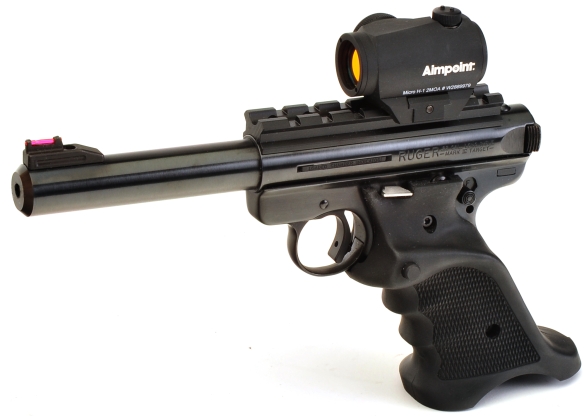
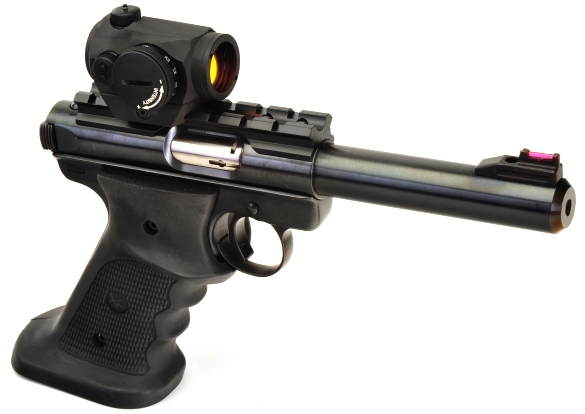
The Aimpoint is the forth red dot sight that has been mounted on this pistol. The first three, low end sights, were installed and removed as batteries went dead quickly, lining up on the eyepiece was so critical that shooting with both eyes open was next to impossible and the budget sights looked cheap and… clunky. I know, easy on the high tech adjectives, Joe. The Micro H-1 is a quality mechanical assembly and its red dot is centered at the factory. Subsequently, very little adjustment was required to get the Ruger on the paper. These were the first twenty-five yard groups shot with this combination.

I’m not a bullseye shooter, so for me these are good five shot groups. Better yet, without the use of expensive target ammo, but rather Remington 22 Yellow Jacket HP, the same type of inexpensive ammo I use to rid our vegetable garden of pests. Dot intensity was set to “8”.
The Aimpoint sight is so fast and so natural shooting with two eyes open, it was easy to keep a tennis ball bouncing at seven yards or so without much effort. My eye sight isn’t great anymore, so metallic sights, particularly on a handgun, are stressful to use. Consequently, I shoot handguns a lot less these days. With the Aimpoint sight, it was like having twenty year old eyes and shooting was really a pleasure. In fact, my wife and I turned the afternoon into some friendly… sort of, target shooting competition.
Had to try…
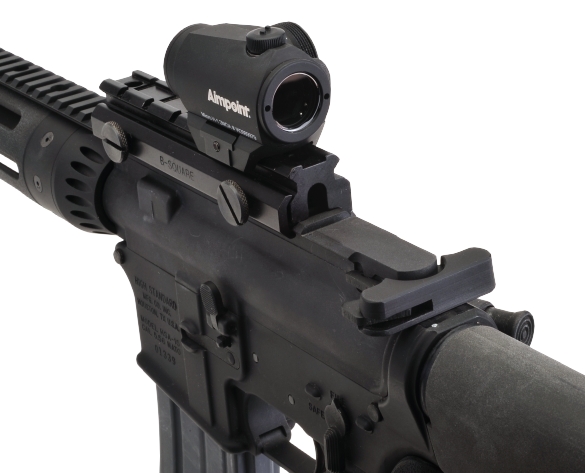
Same Aimpoint on a 3/4″ riser and my thrasher AR-15. With the dot turned down to “6”, fifty yard 1/2″ groups were the norm with Federal, Hornady and Remington 55 – 64 grain ammo and the guns current 9″ twist barrel. That is about where the gun shoots with a conventional scope. The difference is how quickly the Aimpoint can be brought on target, or track a moving target and the weight is so minor the gun is actually lighter than it is with a set of quick detach front and rear metallic sights.
No, it’s not a duck call…
After understanding the purpose and intent behind a red dot sight, there will be those who would like to extract as much potential as possible from their investment. Pictured below, the 3X Magnifier with twist mount. The magnifier Brownells# 100-002-981WB retails in the neighborhood of $560. The twist mount and base runs approximately $180, Brownells # 100-003-597WB. The pictured co-witness spacer that elevates the magnifier, Brownells# 100-004-137WB is priced at about $28. So $768 is the package cost. 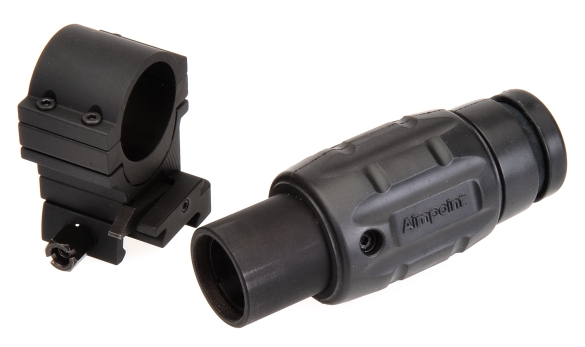
This little magnifying gizmo is actually quite useful, even if… pricey. The magnifier changes the red dot sight system from close fast quarter work to moderate long range shooting and it goes onto, and comes off of, a Picatinny rail equipped rifle with the simple push of a button and a quarter twist of the magnifier. The point of impact and line of sight does not change as the magnifier is passive within the sight system, it only magnifies the image seen through the red dot. The sight can be used with other red dot sights and it can be used as a monocular. Like the Aimpoint Micro H-1, there are competitors making similar products, some good quality, some cheaply made.
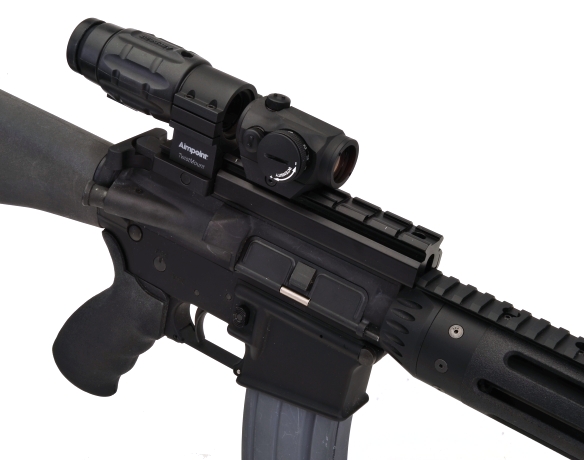
Rather than rely on my strained descriptions… Above, the 3X magnifier mounted on my test flogger AR 15. The Aimpoint is on a riser, which makes for a comfortable shooting position. The 3X magnifier on the twist mount is attached the gun’s main Picatinny rail. The result is that both the magnifier and the red dot sight are on the same optical centerline. If I want to remove the magnifier, I only have to push down on a mount lever and the mount’s base will stay in place, but the sight and balance of the mount can be removed.
There are some downsides to the 3XMag other than cost in that it introduces conventional riflescope characteristics: parallax, 7° FOV, 7mm exit pupil, 65 mm eye relief at full FOV, and reduced light transmission. I’d chalk this one up to use for a specialized application where cost is no object… government based spending.
Closing arguments… sometimes it feels that way
Suggesting there is no appreciable difference between a $600 Aimpoint Micro H-1 red dot and a $100 knock-off is tantamount to saying a Ferrari 458 Italia has nothing more to offer than a Ford Focus. The reality is that you have to know how to drive a Ferrari to utilize its potential and you have to want, or need, the performance that the Ferrari has to offer… otherwise its ownership mostly represents the superficial lout who stole your girlfriend.
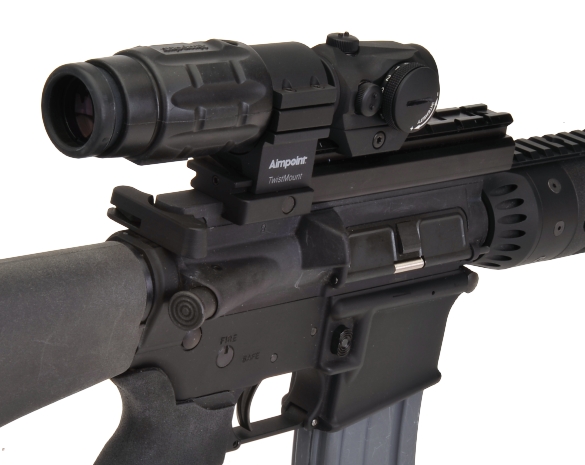
No parallax, five year battery life and a sight that can be flooded, heated, frozen and bounced like a basketball and still works. Yup. There are cheap products, but then there is the type of equipment I like to have on a defensive firearm when I hear the sound of breaking glass in the middle of the night. The Aimpoint Micro H-1 2 MOA Dot is one of them. Nice sight… save your pennies.

Email Notification